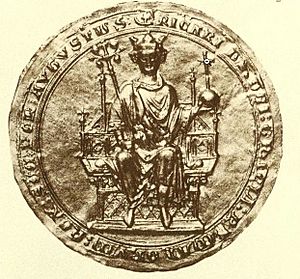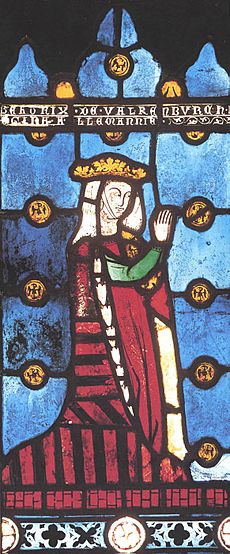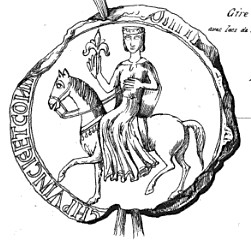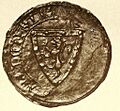Richard of Cornwall facts for kids
Quick facts for kids Richard |
|
|---|---|
| Earl of Cornwall Count of Poitou |
|

Seal of King Richard
|
|
| King of the Romans | |
| Reign | 13 January 1257 – 2 April 1272 |
| Coronation | 17 May 1257 |
| Predecessor | William II of Holland |
| Successor | Rudolf I of Habsburg |
| Born | 5 January 1209 Winchester Castle, Hampshire, England |
| Died | 2 April 1272 (aged 63) Berkhamsted Castle, Hertfordshire, England |
| Burial | Hailes Abbey, Gloucestershire |
| Spouse |
Isabel Marshal
(m. 1231; died 1240) |
| Issue more... |
Illegitimate:
|
| House | Plantagenet |
| Father | John, King of England |
| Mother | Isabella, Countess of Angoulême |
Richard (born January 5, 1209 – died April 2, 1272) was an English prince. He was the second son of John, King of England, and Isabella, Countess of Angoulême. From 1257 until his death, he was the King of the Romans. This was a title for the elected ruler of the Holy Roman Empire, who was expected to become Holy Roman Emperor.
Richard was also known as the Count of Poitou from 1225 to 1243. He held the title of Earl of Cornwall starting in 1225. He was one of the richest people in Europe. Richard went on a journey called the Barons' Crusade. There, he successfully helped free prisoners and helped build a fort in Ascalon.
Contents
Richard, Earl of Cornwall
Early Life and Wealth
Richard was born on January 5, 1209, at Winchester Castle. When he was eight, he became the High Sheriff of Berkshire. In 1225, his brother, King Henry III, gave him Cornwall as a birthday gift. This made him the High Sheriff of Cornwall.
The money Richard earned from Cornwall made him very wealthy. He was one of the richest people in all of Europe. Even though he helped King Henry in battles in Poitou and Brittany, their relationship was often difficult. Richard even rebelled against his brother three times. Each time, King Henry had to give him expensive gifts to make him happy.
In 1233, Richard built Tintagel Castle in Cornwall. Some people think he built it to connect himself with the famous King Arthur legends. This was a way to gain the trust of the Cornish people. The castle itself was not very important for fighting.
First Marriage and Family
In March 1231, Richard married Isabel Marshal. She was a rich widow. King Henry was not happy about this marriage. He worried about the Marshal family because they were powerful and often disagreed with him. Richard became a stepfather to Isabel's six children.
Richard bought Wallingford Castle in Berkshire (now Oxfordshire) in 1231. He spent a lot of money making it a grand home. He and Isabel had four children together. Only one of them, Henry of Almain, lived to be an adult.
Richard disagreed with Simon de Montfort. In 1238, he rebelled because his sister, Eleanor, married Simon. Again, Richard received many gifts to calm him down. When Isabel was dying in 1240, she wanted to be buried at Tewkesbury. But Richard buried her at Beaulieu Abbey instead. As a kind gesture, he sent her heart to Tewkesbury.
Journey to the Holy Land and Second Marriage
Later in 1240, Richard traveled to the Holy Land. He led a group of crusaders during the Barons' Crusade. He did not fight in any battles. Instead, he was a skilled negotiator. He helped free prisoners and arranged for the burial of crusaders. He also helped rebuild the fort in Ascalon, which had been destroyed.
After returning from the Holy Land, Richard visited his sister Isabella. She was the empress of Frederick II.
In 1243, Richard married Sanchia of Provence. She was the sister of King Henry's wife, Eleanor. Richard had met Sanchia on his journey to the Holy Land. This marriage helped connect Richard more closely to the royal family. Sanchia's sisters also married important kings. One married the King of France, and another married the King of Naples. These marriages helped improve the relationship between England and France.
Claims to Poitou and Sicily
Richard was named Count of Poitou before August 1225. However, his claims to lands like Gascony and Poitou were mostly just titles. In 1241, the French king, Louis IX of France, gave Poitou to his own brother.
Richard and King Henry's mother, Isabella, felt insulted by the French queen. They were encouraged to try and get Poitou back. But their military trip failed. Richard gave up his claim to Poitou around December 1243.
Pope Innocent IV offered Richard the crown of Sicily. But Richard thought the price was too high. He said it was like being offered the moon and told to go get it from the sky. Instead, King Henry tried to buy the kingdom for his own son.
Becoming King of Germany
In 1257, Richard was chosen to be the King of Germany. Four of the seven powerful German princes, called Electors, voted for him. Another prince, Ottokar II of Bohemia, first voted for someone else but later supported Richard.
Richard had to pay a lot of money to these princes to get their votes. On May 17, 1257, he was crowned King of the Romans in Aachen. However, this title did not give him much real power. He only visited Germany four times between 1257 and 1269.
Later Life and Death
Richard founded Burnham Abbey in Buckinghamshire in 1263. He also founded the Grashaus in Aachen in 1266.
He joined King Henry in fighting against rebels led by Simon de Montfort. This was during the Second Barons' War (1264–1267). After a big defeat for the king's side at the Battle of Lewes, Richard hid in a windmill. He was found and put in prison until September 1265.
In December 1271, Richard had a stroke. His right side became paralyzed, and he could no longer speak. Richard died on April 2, 1272, at Berkhamsted Castle in Hertfordshire. He was buried at Hailes Abbey, which he had founded. His second wife, Sanchia of Provence, and his son, Henry of Almain, were also buried there.
After Richard's death, there was a struggle for power in Germany. This ended in 1273 when Rudolph I of Habsburg became the new King of the Romans. In Cornwall, Richard's son, Edmund, 2nd Earl of Cornwall, took over as Earl.
Wives and Children
Richard of Cornwall married three times. He had six children who were born in marriage, but none of them had children themselves. He also had some children outside of marriage.
First Wife
Richard first married Isabel Marshal on March 30, 1231. She was the daughter of William Marshal, 1st Earl of Pembroke. Isabel died on January 17, 1240, while giving birth. She was buried at Beaulieu Abbey. Richard and Isabel had four children:
- John of Cornwall (born and died in 1232).
- Isabel of Cornwall (born 1233 – died 1234).
- Henry of Cornwall (born 1235 – died 1271). He was murdered by his cousins. Henry had no children.
- Nicholas of Cornwall (born and died in 1240).
Second Wife
Richard's second marriage was to Sanchia of Provence. They married on November 23, 1243, at Westminster Abbey. Sanchia was one of four daughters of Ramon Berenguer IV, Count of Provence. Her older sister was the Queen of England. Sanchia died on November 9, 1261, and was buried at Hailes Abbey. Richard and Sanchia had two sons:
- An unnamed son (born and died in 1246).
- Edmund, 2nd Earl of Cornwall (born 1249 – died before 1300). He married Margaret de Clare but had no children.

Third Wife
Richard's third wife was Beatrice of Falkenburg. She was known for her beauty. Her father supported Richard's claim to the throne of the Holy Roman Empire. Richard met Beatrice during a battle and was very taken with her. They married on June 16, 1269. She was about fifteen years old, and he was sixty-one. Richard loved his young wife, and she respected him. They did not have any children. Beatrice died five years after Richard, in 1277, and never remarried.
Other Children
Richard had several children outside of marriage. One of his partners was Joan de Vautort. Richard had at least three sons and one daughter with her or other women:
- Philip of Cornwall, who became a priest.
- Sir Richard of Cornwall. He was killed by an arrow in 1296. His daughter, Joan of Cornwall, is an ancestor of the Howard family, who are the Dukes of Norfolk.
- Sir Walter of Cornwall. He was an ancestor of the Cornwall family of Brannel.
- Joan of Cornwall. She married twice and had children from her first marriage.
Images for kids
-
Richard's arms: Argent, a lion rampant gules crowned or a bordure sable bezantée as drawn by his contemporary Matthew Paris (d.1259)
See also
 In Spanish: Ricardo de Cornualles para niños
In Spanish: Ricardo de Cornualles para niños






